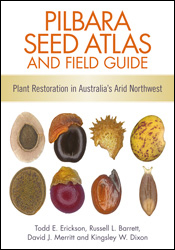
Erickson, Todd E., Barrett, Russell L., Merritt, David J. and Dickson, Kingsley W. (eds) (2016) Pilbara seed atlas and field guide: plant restoration in Australia’s Arid Northwest. CSIRO Publishing, Clayton, Vic.
The Pilbara is an area we associate with mining particularly of iron ore and, previously, for its pastoral industry. These have had an impact on the landscapes and vegetation of the region: ecological restoration is essential. This restoration should be scientifically sound and based on the native species. Given the physical size of the areas of disturbance, the most cost-effective way is by seeding. To do this specific knowledge is needed on the seeds—time to harvest, cleaning, storage, dormancy and germination and how then to systematically approach the restoration as a whole.
This book addresses these areas exhaustively. It is written by plant scientists who have worked in the area and is easily accessible by any interested person. It is the result of work by BHP Billiton, UWA and Kings Park (BGPA).
The first chapter explains the difficulties posed by the area – ancient geology; six different landscapes ranging from lowlands, wetlands, rocky slopes to plateau; climatic extremes, including high temperatures and cyclonic rains. The total plant diversity is nearly 1800 species (15 per cent endemic, 10.6 per cent have conservation priority and 8.8 per cent are yet to be described). The following three chapters discuss collection, viability and treatment/storage of seeds; problems of dormancy and germination rates; and how to manage seed-based restoration.
The core of the book (214pp) is the atlas. 103 species are detailed: 2 pages on each giving common and indigenous names, descriptions, identification features, map, habitat, seed details as tested and photographs of the plants, flowers, fruit and seeds. It includes a series of appendices (dormancy and suggested pre-treatments; smoke water preparation and application; list of vascular plants of the Pilbara), glossary and index.
This is a clearly set out and readable book, looking at some Pilbara plants and an excellent hand book for those involved in restoration in the Pilbara. For those travelling in the area it would be a useful but limited (103 species) reference book on the plants of the area. Our biodiversity needs more of these types of guides for other areas.
Margaret Larke

